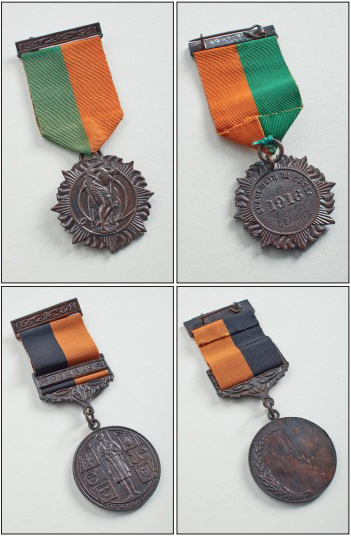1916–21 military service medals
Published in Artefacts, Issue 2 (March/April 2021), Volume 29By Lar Joye

Above: 1916 medal, front and back (top); service medal, 1917–21, front and back (above). (Kilmainham Gaol Museum/OPW)
During the twentieth century the Irish Defence Forces have, like other armies, issued bravery medals (the Military Medal for Gallantry and the Distinguished Service Medal), service medals, UN medals and, more recently, EU operation medals. In addition, four service medals were issued for the revolutionary period, covering the period from April 1916 to July 1921:
1916 medal—created in 1941, 2,594 issued.
Service medal, 1917–21—created in 1942, 70,000 issued.
1916 survivor’s medal—created in 1966, 968 issued.
Truce anniversary medal—created in 1971, 22,445 issued.
The 1916 medal was created in January 1941 at the height of the Emergency (1939–45) and was issued to those who had served during Easter Week 1916, many of whom were now serving in the expanded Defence Forces. That year (1941) also marked the 25th anniversary of the 1916 Rising. The figure on the medal is a reproduction of the statue in the GPO of ‘The Death of Cuchulainn’, designed by Oliver Sheppard in 1914 and chosen by Eamon de Valera in 1935 to commemorate the nineteenth anniversary of the Rising. The Ulster hero Cuchulainn was the leader of the Red Branch Knights. Mortally wounded, he bound himself to a pillar in an upright position to fight his enemies, but they feared to attack him until a raven landed on his shoulder, proving that he was dead. The sunburst is taken from the Irish Defence Forces cap badge, while the back is plain, with the inscription ‘Seaċtain Na Cásca 1916’ (Easter Week 1916). The first 100 veterans received their medals from An Taoiseach on 19 April 1941 at a ceremony in Collins Barracks in Dublin. In 1942 a service medal for the War of Independence was created, bearing an image of a typical IRA Volunteer flanked by the arms of the four provinces of Ireland, inscribed with ‘ÉIRE’ and ‘Cogadh na Saoirse’ (Fight for Freedom). This medal was issued with a bar inscribed ‘Comhrac’ (Struggle) for veterans who had seen active military service. Unlike British Army medals, these were not inscribed with the name of the recipient, which makes identifying them difficult and also makes them easy to fake. It was up to the recipients to have their names engraved on the medals. The only exceptions were those who had died during the revolutionary period or in the intervening 25 years—they did have their names inscribed. Following the Easter Rising 50th anniversary commemorations, survivors’ medals based on the originals, but slightly smaller in size, were issued in 1966 and 1971.
Lar Joye is Heritage Officer of Dublin Post.
















